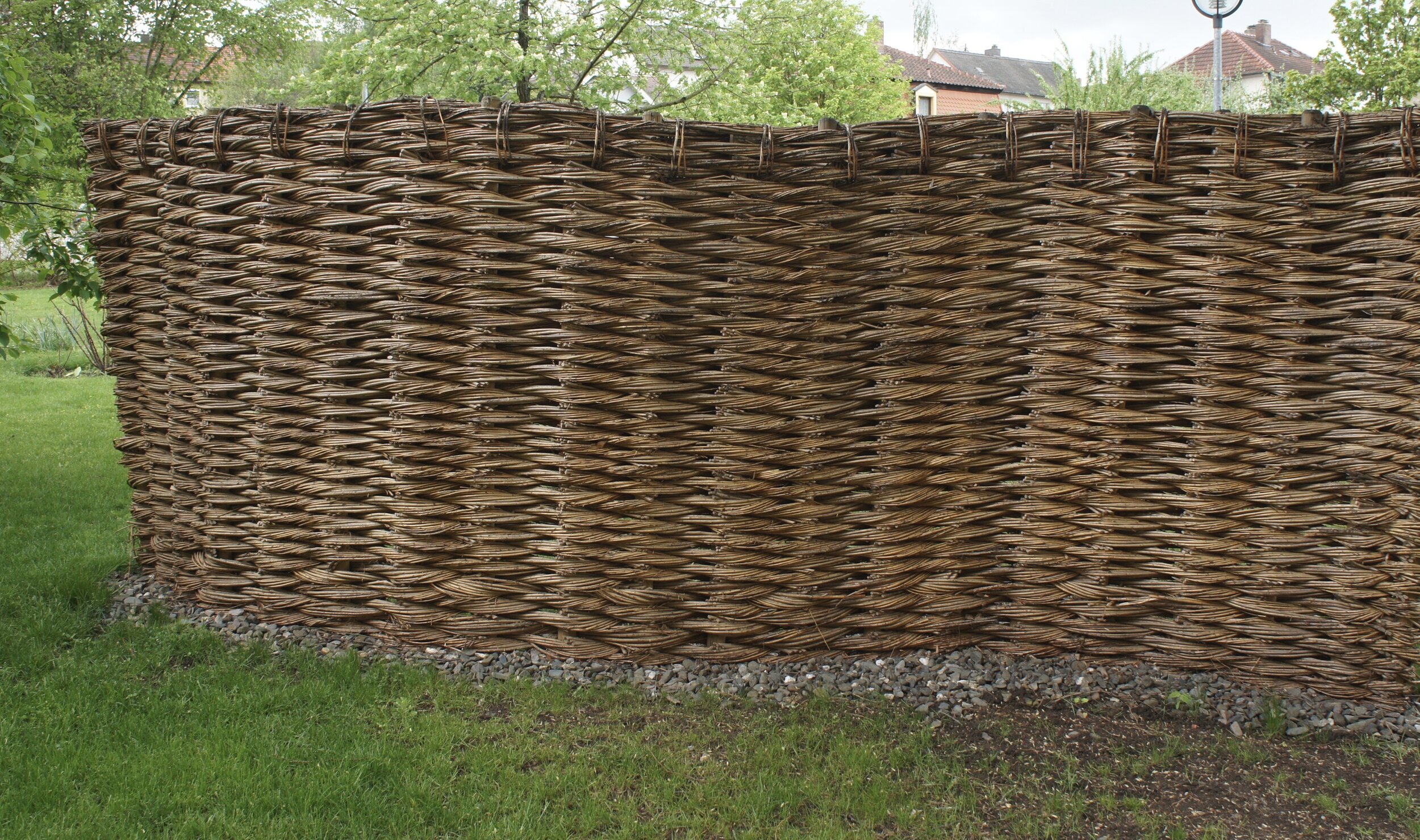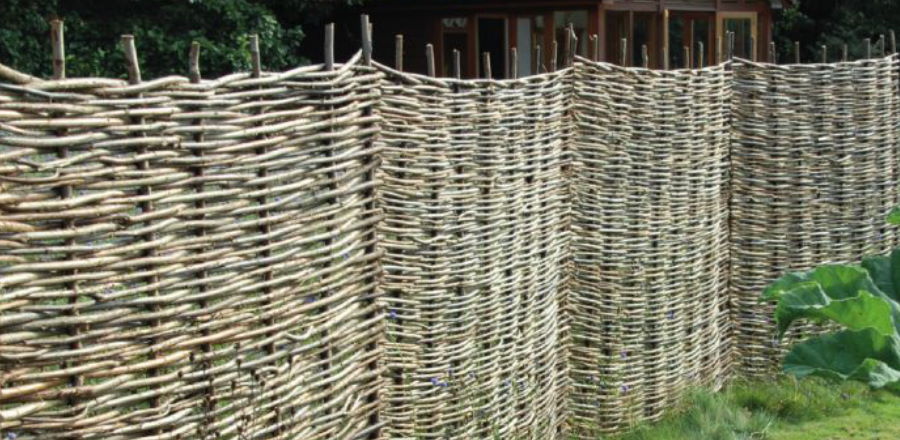
“Willow Fencing | Golden Gate Park, SF …” from www.flickr.com and used with no modifications.
Key Takeaways
Willow, hazel, and reed are traditional, eco-friendly materials for building wattle fence panels, offering a sustainable alternative to bamboo screens.
Willow is highly flexible, making it perfect for weaving, while hazel provides strength and durability, and reed adds a unique aesthetic.
Choosing the right branches is crucial; look for flexibility, strength, and the ability to withstand your local environment.
Introduction
When it comes to designing your garden, there’s something deeply satisfying about incorporating elements that blend tradition with sustainability. Wattle fence panels are a testament to this blend, offering a quaint, rustic charm that’s not only visually appealing but also eco-friendly. If you’re seeking a natural garden screen, wattle fencing is a fantastic alternative to bamboo, and it’s something you can create with your own hands.
I. Materials for Wattle Fences
Willow: The Flexible Foundation for Wattle Fencing
Willow is one of the most popular choices for wattle fences due to its incredible flexibility. This quality makes it ideal for weaving through the upright stakes that form the structure of your fence. Moreover, willow has a growth advantage; it can root and sprout leaves, eventually transforming into a living fence that provides both privacy and greenery.
When selecting willow for your fence, you want to look for branches that are green and fresh. These are more pliable and easier to work with, ensuring a tighter weave and a sturdier fence. Plus, the fresh willow has a vibrant color that weathers to a lovely silvery gray, adding a dynamic element to your garden’s palette.
Hazel: The Sturdy and Sustainable Choice
Hazel branches are another excellent option for wattle fencing, prized for their combination of flexibility and strength. A hazel wattle fence will stand firm against the elements, providing a robust barrier for your garden. It’s also a sustainable resource; hazel coppices well, meaning it regrows quickly after being cut, allowing you to harvest branches without harming the environment.
The best time to cut hazel branches is in the winter when the sap is down, which ensures they are at their most durable. When weaving, young and supple hazel rods are preferable, as they can be easily bent into shape, creating a tight and resilient weave.
Reed: Aesthetic and Eco-friendly Options
Reed is a material that brings a different texture and feel to your wattle fence. It’s usually finer and can be densely packed to give a solid appearance with a warm color tone. Reed is particularly suitable for creating lighter, more decorative panels that can be used to accentuate certain areas of your garden.
It’s worth noting that reed fencing can last a decade or more, depending on the climate and how well it’s maintained. It’s naturally resistant to pests like termites, which means less worry about maintenance. Just like willow and hazel, reed is a renewable resource, making your wattle fence a choice you can feel good about.
Example: A wattle fence made from reed can provide a delicate screen for a cottage garden, blending seamlessly with the surrounding flora while offering a sustainable solution to garden privacy.

II. Wattle vs Bamboo Fencing
Aspect |
Wattle Fencing |
Bamboo Fencing |
|---|---|---|
Environmental Impact |
– Environmentally friendly and sustainable. – Aesthetic appeal with a rustic look. – Cost-effective compared to traditional fencing options. – Easy to make with materials found in nature. |
– Bamboo is a fast-growing grass that replenishes quickly. – Absorbs carbon dioxide and other toxic gases, reducing pollution. – Sustainable building material. – Easy to replace and maintain. |
|
Durability |
– Requires regular maintenance and repair. – Not as durable as some modern fencing materials. – Attracts pests like termites if not properly treated. |
– Long-lasting and durable. – Minimal maintenance required. – Resistant to environmental elements like heat, UV rays, rain, and snow. |
|
Aesthetic Appeal |
– Provides a rustic and natural look. – Can be woven in various patterns like basket weave, wicker, and herringbone. |
– Exotic and attractive fencing option with a natural finish. – Available in different colors for customization. – Develops a beautiful silvery sheen as it ages. |
|
Cost |
– Relatively inexpensive compared to other fencing options. |
– More expensive than traditional wood, vinyl, or metal fences. – Costly to transport in some regions due to availability constraints. |
|
Availability |
– Materials commonly found in nature, depending on the region. |
– May not be easily available in all climate conditions and may need to be specially ordered in some regions. |
|
Maintenance |
– Regular maintenance required to ensure longevity and prevent issues like rotting and cracking. |
– Minimal maintenance needed due to durability and resistance to environmental elements. |
|
Installation |
– Relatively easy to make with materials at hand but requires weaving skills for proper construction. |
– Easy installation process suitable for DIY projects without the need for professional help in most cases. |
|
Longevity |
– Lasts around 10 years or longer depending on climate conditions and maintenance efforts. |
– Long-lasting with proper care and maintenance, providing years of service without significant deterioration if well-maintained. |
III. Choosing the Best Branches for Wattle Fences
The secret to a sturdy and beautiful wattle fence lies in the branches you choose. It’s not just about picking any stick; you need branches that are strong yet flexible enough to weave without breaking. The branches should also be resistant to rot and pests to ensure your fence stands strong year after year.
Identifying Quality Willow Branches for Flexibility and Growth
Willow branches are best harvested in late winter or early spring when the sap is starting to rise, and the branches are most pliable. Look for straight, long branches with a consistent diameter for an even look. You want branches that can bend without snapping, as they’ll need to be woven tightly between the stakes.
Another tip is to soak the willow branches in water if they’re not as flexible as you’d like. Soaking can restore some of the pliability, making them easier to work with. Remember, the fresher the willow, the better it will weave and root if you’re aiming for a living fence.
Harvesting Hazel Branches: Timing and Technique Matters
For hazel, the best time to harvest is during the dormant season, typically between November and February. This is when the branches are least likely to split as you work with them. Choose straight shoots that have grown in the last year for the best balance of strength and flexibility. To complement your hazel branches, consider using woven bamboo fence panels for a natural garden screen.
When cutting hazel, use sharp, clean tools to make a clean cut that will heal quickly, preventing disease. Also, consider the wildlife; leaving some branches for habitat can be part of your garden’s ecosystem approach.
Reed Selection: Finding the Right Thickness for Weaving
With reed, thickness and rigidity are the primary concerns. You’re looking for reeds that are sturdy enough to stand up once woven but not so thick that they become inflexible. The ideal reed should have a bit of give when you apply pressure, indicating that it can be woven without breaking.
Weaving Techniques for Optimal Fence Strength
The strength of your wattle fence is not just about the materials but also how you weave them. A basic over-and-under pattern is most common, but for added strength, consider a double weave, passing the branch over two stakes before going under the next. This technique creates a tighter, more secure fence.

Conclusion
Wattle fencing is more than just a barrier for your garden; it’s a statement of craftsmanship and environmental consciousness. By choosing materials that are sustainable and locally sourced, you’re contributing to a greener future. And by engaging in the ancient craft of wattle making, you’re creating something that has both functional and aesthetic value.
Frequently Asked Questions (FAQ)
As with any garden project, you might have questions about wattle fences. Here are answers to some common queries to help you get started on your wattle fencing journey.
How long do wattle fences typically last?
A well-constructed wattle fence can last anywhere from 8 to 15 years, sometimes longer if maintained properly. The lifespan depends on the materials used, the climate, and whether the fence is living or not. Regular checks and minor repairs can extend its life significantly.
Are there any special care instructions for wattle fences?
Wattle fences are relatively low-maintenance. However, it’s a good idea to inspect your fence periodically for any signs of damage or rot. If you notice any broken or rotting branches, replace them to maintain the fence’s integrity. Applying a natural wood preservative can also help protect against the elements.
Can wattle fences be repaired or must they be entirely replaced?
One of the beauties of wattle fencing is that it’s easily repairable. Individual branches can be replaced without dismantling the entire fence. This not only makes repairs simpler but also allows you to refresh the look of your fence as needed.
Is wattle fencing suitable for all climates?
Wattle fencing is versatile and can be suitable for a variety of climates. In damp environments, choosing rot-resistant woods and applying natural preservatives can help extend the life of your fence. In dry climates, most woods will perform well, though regular hydration might be necessary for living fences.
Can I use other materials besides willow, hazel, or reed for wattle fencing?
Absolutely! While willow, hazel, and reed are traditional choices, you can use other flexible, woody materials that are available in your area. Alder, maple, and birch are also suitable for wattle fencing. The key is to choose branches that are flexible enough to weave and sturdy enough to last.






